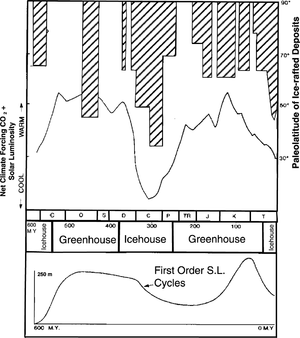Sea level cycles and climate
| Exploring for Oil and Gas Traps | |

| |
| Series | Treatise in Petroleum Geology |
|---|---|
| Part | Predicting the occurrence of oil and gas traps |
| Chapter | Predicting reservoir system quality and performance |
| Author | Dan J. Hartmann, Edward A. Beaumont |
| Link | Web page |
| Store | AAPG Store |
Global climatic effect of cycles
The earth's climate has ranged from times of cooler temperatures (icehouse) to times of warmer temperatures (greenhouse).[1] Continental glaciation characterizes icehouse conditions and causes large sea level changes because ice ties up large volumes of water. Sea level changes are small during greenhouse times because the ice volume is smaller. Globally, sea level falls during glaciation and rises during deglaciation.
The table below summarizes characteristics of fourth- and fifth-order sea level cycles during icehouse, greenhouse, and transitional periods.
| Characteristic | Icehouse | Transition | Greenhouse |
|---|---|---|---|
| Amplitude (m) | High (50–100) | Moderate (20–50) | Low (1–20) |
| Dominant frequency (k.y.) | 100 | 50 | 20 |
Greenhouse vs. icehouse times

The chart in Figure 1 shows periods of icehouse and greenhouse conditions. Also shown are age and paleolatitudes of ice-rafted deposits (bar chart), net climate forcing CO2+ solar luminosity (upper curved line), and the Vail sea level curve (lower curved line).
Regional climates
Arid or humid conditions can occur simultaneously in different regions during icehouse or greenhouse periods. The aridity or humidity of a region strongly affects carbonate deposition and diagenesis. For example, carbonates deposited under arid conditions tend to be associated with evaporites, and carbonate sequences are partly to completely dolomitized. In humid regions where rainfall is greater, carbonates are subject to greater dissolution; therefore, vuggy porosity and karst features are common.
Sea level and climate
Long-term sea level cycles influence regional climates.[2] More humid conditions tend to prevail during deposition of transgressive system tracts, and more arid conditions tend to prevail during deposition of late highstand-lowstand system tracts. Climatic conditions of an area are likely to be arid when a platform interior is subaerially exposed during long-term, sea level late highstand and lowstand. From the Precambrian to the Silurian (see International Chronostratigraphic Chart for information on how the Precambrian Eon and the Silurian Period fit into the international time scale), the lack of land plants might have amplified this aridity. Humid conditions prevail when extensive shallow epicontinental seaways present during long-term transgressions cause increased rainfall.
Sedimentation rate and climate
Light is a critical element of carbonate sedimentation. The photic zone in tropical carbonate settings is only 20–30 m. This is contrasted to cooler water carbonate settings where the photic zone extends to length::100 m or deeper. Tropical carbonate faunal assemblages strongly depend on light, which is why sedimentation rates below length::10 m water depth drop rapidly. Carbonate-producing assemblages of temperate zones do not have a strong light dependence; hence, the sedimentation rate, although lower, is constant from the surface to more than length::100 m water depth.[2]
The table below contrasts features of tropical carbonate settings with temperate carbonate settings.
| Characteristic | Tropical carbonate settings | Temperate carbonate settings |
|---|---|---|
| Photic zone depth | 20–30 m | 100 m+ |
| Sedimentation rate | High in length::10 m or less of water, then rapid drop | Low but more constant in water length::100 m or deeper |
| Dominant fauna | Reef-building assemblages (light-dependent biota) | Bryozoans, mollusks, forams, crinoids (biota not as light dependent) |
| Depositional topography | Reef-rimmed platforms | Gently sloping ramps on prograding seaward-thickening sediment wedges |
See also
- Predicting carbonate porosity and permeability
- Carbonate facies
- Carbonate diagenesis
- Carbonate diagenetic stages
- Early carbonate diagenesis
- Basics of carbonate porosity formation and preservation
- Sea level cycles and carbonate sequences
- Sea level cycles and carbonate diagenesis
- Sequences during low-amplitude, high-frequency cycles
- Sequences during moderate-amplitude, high-frequency cycles
- Sequences during high-amplitude, high-frequency cycles
- Predicting carbonate reservoir location and quality
References
- ↑ Read, J., F., Horbury, A., D., 1993, Eustatic and tectonic controls on porosity evolution beneath sequence-bounding unconformities and parasequence disconformities on carbonate platforms, in Horbury, A., D., Robinson, A., G., eds., Diagenesis and Basin Development: AAPG Studies in Geology 36, p. 155–197.
- ↑ 2.0 2.1 2.2 Read, J., F., 1995, Overview of carbonate platform sequences, cycle stratigraphy and reservoirs in greenhouse and ice-house worlds, in Read, J., F., Kerans, C., Webber, L., J., Sarg, J., F., Wright, F., M., eds., Milankovitch Sea-level Changes, Cycles, and Reservoirs on Carbonate Platforms in Greenhouse and Ice-house Worlds: SEPM Short Course 35, 183 p. Good summary of concepts of climatic effect on sea level cycles, carbonate deposition, and reservoir development.